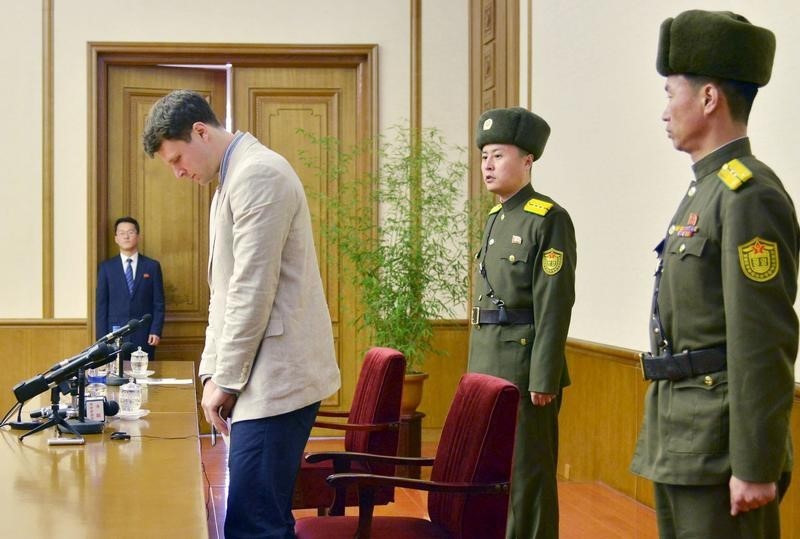Otto Warmbier, the American student imprisoned in North Korea for 17 months, died on June 19, six days after he was flown back to the US.
Warmbier was detained as he was leaving Pyongyang in January 2016 and sentenced to 15 years of hard labor on the grounds that he attempted to steal a banner with political slogans.
On June 13, Warmbier was medically evacuated from North Korea, reportedly in a coma, and flown to Cincinnati.
Doctors caring for Warmbier said the 22-year-old was experiencing “unresponsive wakefulness,” a term that has come to replace the “persistent vegetative state.”
"He was unable to speak, unable to see and unable to react to verbal commands," Warmbier's parents wrote in a statement announcing his death.
That statement, however, did not mention a specific cause of death beyond the "awful tortuous mistreatment our son received at the hands of the North Koreans." That has left many wondering what the final factor was that led to the young man's death.
Doctors at the University of Cincinnati Medical Center, where Warmbier was being treated, analyzed two MRI scans sent by the North Koreans, according to The New York Times. From those, they saw that Warmbier had sustained a severe neurological injury.
Warmbier's parents said they were told their son went into a coma soon after his sentencing, and the doctors' analysis suggested that was the case. They estimated the catastrophic brain injury most likely came before April 2016.
The doctors said Warmbier's loss of brain tissue was most likely caused by an extended period of oxygen deprivation.
"This pattern of brain injury is usually seen as result of cardiopulmonary arrest where the blood supply to brain is inadequate for a period of time resulting in the death of brain tissue," Dr. Daniel Kanter, director of the Neurocritical Care Program at the University of Cincinnati Medical Center, said in a press conference, according to CNN.
Warmbier's brain, in other words, was cut off from oxygen at some point, likely because his heart stopped, which halted the regular supply of blood.
But that does not fully explain how he died. Patients have been known to remain in a state of "unresponsive wakefulness" - in which they can open their eyes and have functioning reflexes, but are unresponsive to commands and other tests of consciousness - for long periods of time.
Medical experts have publicly speculated about an array of potential causes of death related to Warmbier's condition, including pneumonia, infection, and blood clot. But we're unlikely to ever know the truth about what happened, since so much time passed between his initial injury and ultimate death.
The North Koreans have claimed that Warmbier's condition was due to a case of botulism that he contracted after his trial, combined with the effects of a sleeping pill. Fred Warmbier, Otto's father, has refuted that account, and doctors said they did not find any current signs of botulism.
Doctors also found no evidence of broken bones or other injuries that would suggest Warmbier was physically abused - though cuts and bruises would have had plenty of time to heal. An Ohio coroner is investigating Warmbier's death, but the Washington Post suggests that an autopsy is unlikely to reveal any useful information, since it would be hard to tell when any damage to bones or organs occurred (if they found such evidence).
The name for the condition Warmbier was in before his death - "unresponsive wakefulness" - emerged around 2010 because many doctors saw the term "vegetative" as pejorative, since it suggested that a patient was somehow similar to a vegetable. The notion of a vegetative state dates to the 1800s, when anatomist and pathologist Marie Francois Xavier divided the human nervous system into animalic and vegetative functions. Vegetative, according to this early definition, included many involuntary, automatic functions, like the cardiovascular and respiratory systems. The animalic processes were the ones that helped a person perceive and understand their environment - intellect, locution, senses, and so forth.
The modern conception of a vegetative state was first put forth in a 1972 paper as a way to describe medical patients whose sleep cycles and automatic functions continued somewhat normally, but who didn't exhibit any awareness of their own self or external environment. But in recent years, the term "unresponsive wakefulness syndrome" has increasingly been used instead of "vegetative state" to avoid negative associations.
A 2013 review of cases of unresponsive wakefulness syndrome suggests that patients in that state have neuronal function levels that remain below the threshold required for them to experience consciousness. Their chances of recovery depend on how far their neuronal activity is from this necessary level. But the longer they remain in that state, the lower those chances seem to be.

